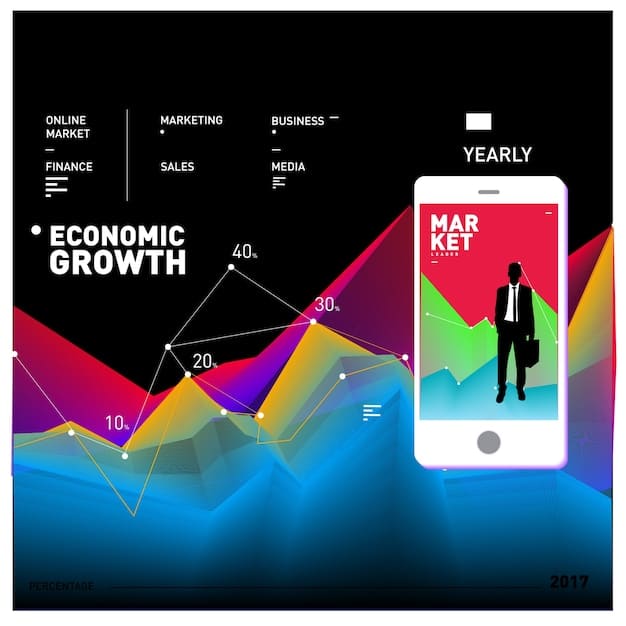Dow Jones Reaches Record High: Implications for Investors & Growth

The Dow Jones Industrial Average recently achieved a historic high, signaling strong investor confidence and potential prospects for business expansion in the US economy.
The financial news is buzzing with the Dow Jones Industrial Average reaching a record high. But what does this mean for the average investor and the broader outlook for business growth in the United States? Let’s dive into the details.
Dow Jones Breaks Records: A New Era for the Stock Market?
The recent surge of the Dow Jones Industrial Average captures headlines globally. It’s more than just a number; it’s an indicator of where the market is headed. We’ll dissect what fueled this rally and what it suggests about the health of the American economy.

Understanding the Dow’s Composition and Recent Performance
Before we delve deeper, it’s essential to understand what the Dow Jones Industrial Average represents. It’s a price-weighted index that tracks 30 large, publicly-owned companies based in the United States. These companies span various sectors, making the Dow a barometer for the overall economy.
- Key Sectors Driving Growth: Technology, financials, and healthcare often play significant roles.
- Influence of Global Events: Geopolitical stability or instability can heavily impact the Dow.
- Monetary Policy Impact: Federal Reserve decisions on interest rates have a direct effect.
The sustained growth of the Dow often indicates that investors are optimistic about future earnings and economic conditions. However, it’s crucial to remember that the Dow is just one indicator and doesn’t paint the whole picture of the economic landscape.
In summary, the Dow’s rise is a complex interplay of various economic factors. Its significance relies on understanding its composition and the broader macroeconomic context.
Investor Confidence Soars: How the Dow Impacts Sentiment
A record-breaking Dow can have a profound effect on investor psychology. It can encourage both seasoned professionals and everyday individuals to increase their investment activity, fueling further market growth.
The Psychology Behind a Bull Market
When the Dow steadily climbs, it fosters a sense of optimism among investors. Success stories proliferate, and people become more willing to take risks, betting on continued upward momentum.
- Increased Risk Appetite: Investors might shift from safe assets to higher-yield investments.
- FOMO (Fear of Missing Out): This drives more people to invest, often leading to market bubbles.
- Long-Term Investment Strategy: Many see it as a green light to stick with their existing plans.
However, this euphoria can also create vulnerabilities. Overconfidence can lead to irrational investment decisions, especially if people fail to do their due diligence.

Therefore, while high investor confidence is generally positive, it’s essential to maintain a balanced perspective and avoid impulsive actions driven solely by market hype.
Overall, the psychological impact of a rising Dow can be significant, but prudent investors should always temper their enthusiasm with careful analysis and strategic planning.
Business Expansion: Opportunities Stemming from a Strong Dow
A climbing Dow Jones often correlates with increased business investment and expansion. When corporate leaders see positive market signals, they are more likely to allocate capital to new ventures and growth initiatives.
Capitalizing on a Booming Stock Market
A strong Dow can create a favorable environment for businesses across diverse sectors. It often results in easier access to funding, improved consumer spending, and overall economic stimulus.
Entrepreneurs and established companies alike can leverage a robust stock market to drive various growth strategies, including:
- Increased Hiring: Confidence in future earnings leads to more job creation.
- Research and Development: Innovation gets a boost with higher budgets.
- Mergers and Acquisitions: Companies use their strong stock value to acquire competitors.
Furthermore, businesses may find it easier to attract top talent, as skilled professionals are drawn to companies that show financial stability and growth potential.
In essence, a high-performing Dow Jones presents businesses with a range of opportunities to expand, innovate, and solidify their market positions. It fuels a virtuous cycle of economic growth.
In summary, the Dow’s performance acts as a catalyst for corporate expansion, driving employment, innovation, and strategic moves across industries.
Dow’s Record High: Sector Winners and Losers
When the Dow reaches a record high, not all sectors benefit equally. Some industries thrive while others lag behind. Understanding these dynamics can provide valuable insights for investors.
During a Dow surge, several sectors often lead the charge:
- Technology
- Financials
- Healthcare
Conversely, sectors like utilities or consumer staples may experience slower growth due to their defensive nature—investors often flock to these during economic downturns, not bull markets.
Understanding Sector Rotation
Investors should watch for “sector rotation,” a phenomenon where money flows from one industry to another based on economic cycles and anticipated growth. Staying ahead of this trend can boost investment returns.
In essence, the Dow’s overall strength does not guarantee uniform success across all sectors. Investors should carefully analyze industry-specific factors to make informed decisions, capitalizing on potential sector leaders while mitigating risks associated with underperforming areas.
The Role of Global Economic Indicators
The Dow Jones Industrial Average doesn’t operate in isolation. Global economic indicators, such as international trade agreements, currency fluctuations, and geopolitical events, all play a significant role in its performance.
External Factors Influencing the Dow
Global trade policies can significantly impact the earnings of multinational companies listed on the Dow. For example, new tariffs or trade agreements can either boost or hinder their profitability, thus affecting their stock prices.
Currency fluctuations also play a role. A stronger US dollar can make exports more expensive, potentially reducing international sales for Dow-listed companies. Conversely, a weaker dollar can boost exports but may also lead to higher import costs.
Geopolitical events, such as political instability or conflicts in key regions, can create uncertainty in the market, causing volatility in the Dow. Investors often react to such events by adjusting their portfolios, which can either drive the index up or down.
Ultimately, a holistic understanding of these global economic indicators is essential for anyone looking to grasp the full context of the Dow’s performance and make informed investment decisions based on this knowledge.
Risk Assessment and Future Projections
While the Dow Jones reaching a record high is generally positive, it’s crucial to assess the risks and consider future projections. Overoptimism can sometimes blind investors to potential pitfalls.
Balancing Optimism with Caution
There are several potential risks to consider when the Dow soars to new heights. One of them is the possibility of a market correction. It’s a sharp decline in stock prices, can occur unexpectedly and erase gains quickly. Market corrections are a natural part of the economic cycle, but they can be painful for investors who are not prepared.
Future Projections and Scenarios
Predicting the future of the Dow is challenging, but analysts use various models and economic indicators to forecast potential scenarios. Factors like GDP growth, inflation rates, and interest rate policies play significant roles in these projections.
Regardless of the projections, investors should always be prepared for different scenarios, both positive and negative. Diversification is a crucial strategy for mitigating risk. By spreading investments across different asset classes and sectors, investors can reduce the impact of any single investment performing poorly.
In conclusion, the Dow reaching a record high presents both opportunities and risks. By carefully assessing those factors, the investors and businesses alike can position themselves for success.
| Key Point | Brief Description |
|---|---|
| 📈 Record High | Dow Jones reaches unprecedented levels. |
| 💸 Investor Confidence | Increased optimism boosts market activity. |
| 💼 Business Growth | Corporations invest in expansion and innovation. |
| 🌐 Global Impact | International events influence market dynamics. |
FAQ
▼
A record Dow typically signals strong economic health and investor confidence, leading to increased business investments, job creation, and overall economic growth.
▼
High investor confidence encourages more investment, which drives up stock prices and creates a positive feedback loop, potentially leading to a bull market.
▼
Technology, financials, and healthcare sectors often see the most significant gains as investors seek growth opportunities during a strong market period.
▼
Risks include overvaluation, market corrections, and increased volatility, which can lead to sudden losses if the market sentiment changes or unforeseen events occur.
▼
Global factors like trade agreements, currency fluctuations, and geopolitical events can significantly influence the Dow by affecting businesses’ earnings and investor sentiment.
Conclusion
The Dow Jones Industrial Average’s record-breaking performance is a multifaceted event that offers both significant opportunities and potential risks. Understanding the interplay between investor confidence, business expansion, sector dynamics, and global economic indicators is crucial for making informed financial decisions. While optimism is warranted, investors must remain vigilant, applying balanced and strategic approaches to navigate the ever-evolving market landscape.





